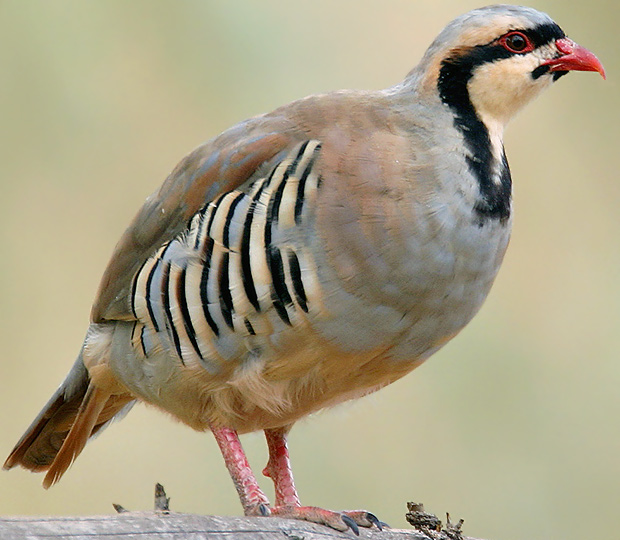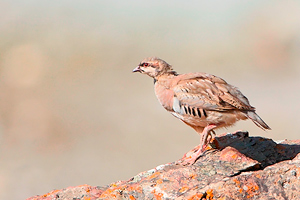| Kingdom: Animalia
Phylum: Chordata Class: Aves (Birds)
Order: Galliformes Family: Phasianidae | |
Chukar Partridge was earlier considered to be conspecific with Rock Partridge (Alectoris graeca), but is now considered a distinct species. There are fourteen geographical subspecies that range from Turkey and Mediterranean islands in the west to India and central Nepal in the east. Chukar has also been successfully introduced, as a game bird into western North America, the Hawaiian Islands, England and New Zealand. Chukar Partridges are mostly gray with shading of brown in the tail and the secondary wing feathers. They have striking rib-like barring of black, brown and buff on the flanks. A black band from the eyes, runs down to below the neck to form a necklace. Neck, throat and chin are whitish and belly area is buff colored. Sexes are similar, with the female slightly smaller in size and having a smaller spur. Both sexes share the bright crimson red bill and legs. Males weigh up to 700 gm and the females weighing slightly less, up to 600 gm. During the breeding season chukars feed in pairs; for the rest of the year feeding occurs in parties of 4 to 5, usually en route to watering areas. Coveys of as many as 40 or more will form during winter when the birds descend to lower altitudes. Foraging occurs on the ground in early morning and late afternoon. The bulk of Chukar's diet is composed of grass seeds, grass blades, basal shoots, bulbs, stems, leaves, plant buds and cereals. Animal foods consist primarily of termites, caterpillars, crickets, ants, and insect eggs. While the diet of young chukars includes a high proportion of insects; adult birds may consume not more than 15% by volume. In winters the Chukar Partridge will dig through up to 20 cm of snow for food. Chukar inhabits open, rocky, dry mountain slopes, hillsides, or canyon walls, often in the neighborhood of terraced cultivation. Steep slopes at least 50 m high and with over 7% gradient are usually preferred. The chukar is also found on open and flat deserts with sparse grasses and on barren plateaus. Optimum habitat includes 25-50% steep, rocky or talus slopes, rock outcrops, cliffs and bluffs, near brushy stream drainages with grasses and water. The hottest part of the day is usually spent in shady cover. They also roost in open rocky places; dense brush cover is probably not required. Chukars roost in coveys, either scattered or in tail-to-tail formations. Rocks and cliffs provide cover from inclement weather. Chukar Partridges are very fast runners and take to wing on reaching the edge of a cliff. Chukars are strong fliers, but fly a short distance, usually downhill, following the contours of the slope to escape predators. During dry summers many coveys can congregate at a waterhole. Water is a major habitat component affecting distribution, especially in summer and distribution is generally limited to habitats that receive 10-50 cm annual rainfall. Chukars exhibit altitudinal migration of upto 15 km moving down from higher altitudes during winter. They may also move onto south-facing slopes to escape inclement weather. Chukars breed monogamously; pairing occurs from late March to August depending on latitude and elevation. During mating season the male defends area only immediately around the female. Males often desert the female after egg-laying. Coveys are formed by one or more broods, often shortly after hatching. Nesting chukars and chukar broods are normally found within 2 km of water. Nests often placed on steep talus slopes or slopes with rocky outcrops, above streams. Chukar nests are depressions scratched in the ground and lined with leaves and feathers, usually well camouflaged under shrubs or among rocks. Eggs are laid at a rate of one per day to one per 2 days. Clutch size ranges from 10 to 20 eggs, with an average of 15. Clutch size is greatly reduced in drought years; in extreme drought, breeding may not occur at all. Re-nesting following clutch loss is normal. Double brooding (production of two consecutive broods in one season) may occur occasionally. The incubation period is 24 days and males apparently assists with incubation and brooding. The precocial young leave the nest shortly after hatching. Individual flight attempts are usually made by 2 weeks of age and, brood flights (where the entire brood makes a flight together) occur by 3 weeks of age, and by 4 weeks of age the chicks have formed flight habits similar to those of adult chukars. The brood and the adult female remain near each other. Chukars have been known to hybridize with other members of the genus on the edge of their range. |
|









